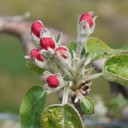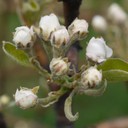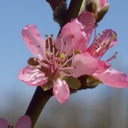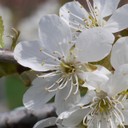Contents
-
Current degree day (DD) accumulations
- Current bud stages
- Orchard Radar
-
Upcoming meetings
The way I see it
- 2010 New England Tree Fruit Management Guide Available
- Tree planting tips
- Pest watch
- Useful links
Current (through April 12) degree day
(DD) Accumulations
Location: UMass Cold Spring Orchard (CSO), Belchertown, MA
Base 43: 244
Base 50: 120
Significant upcoming orchard events based on degree days (Base 43):
Redbanded leafroller first flight peak: 231-367
Spotted tentiform leafminer 1st flight peak: 263-387
Oriental fruit moth 1st catch: 221-325
European red mite egg hatch: 231-337
Obliquebanded leafroller larvae active: 158-314
Pear psylla 1st egghatch: 174-328
McIntosh at pink: 274-312
Current bud stages
| Location | Mcintosh apple -- bud separation to early pink | Gold Bosc pear -- white bud | PF-14 Jersey peach -- 50% bloom | Burgundy (Pearl) cherry -- bloom |
| Belchertown UMass CSO (04/12/10) |
 |
 |
 |
 |
Orchard Radar
Beginning with this Issue of Healthy Fruit, we will begin publishing a synopsis of Glen Koehler's (U. of Maine) Orchard Radar pest predictions for Belchertown, MA (UMass Cold Spring Orchard). Orchard Radar uses SkyBit data as input for apple pest occurrence and development models. Only select short-term output of particular interest will be reported here. For the complete set of models see the link above. If you are interested in getting Orchard Radar for you location, you may want to contact Glen Koehler, glen.koehler1@maine.edu.
- 1st generation OFM flight starts: April 15, Thursday
- 1st RBLR flight began around April 5, Monday. Peak trap catch and approximate start of egg hatch: April 19, Monday.
- 1st STLM flight, peak trap catch: April 27, Tuesday
- Estimated hatch date of overwintered European red mite (ERM) eggs indicating declining efficacy of prebloom oil treatment is Wednesday, April 14
- Friday, Apr 16 McIntosh full pink-extended
Upcoming meetings
April 20, 21, 22 2010: Tree fruit twilight meetings
Tuesday, April 20 -- UMass Cold Spring Orchard, 391 Sabin St., Belchertown, MA
(413) 323-6647Wednesday, April 21 -- Macks Apples of Moose Hill Orchards, 230 Mammoth Rd., Londonderrry, NH (603) 434-7619 (joint meeting with New Hamsphire Fruit Growers' Association and UNH Extension; note meeting starts at 5 PM)
Thursday, April 22 -- Ledge Ends Produce at the historic Briggs Boesch Farm, 830 South Rd., East Greenwich, RI (401) 884-5118 (joint meeting with Rhode Island Fruit Growers' Association)
Tree fruit twilight meetings start promptly at 5:30 PM. (EXCEPT April 21 meeting in New Hampshire which STARTS at 5 PM.) Pesticide recertification credit will be offered but you must be there at start of meeting to receive credit. There will be a $25 meeting admission charged at the door for the Massachusetts and Rhode Island meetings. ($20 for Massachusetts Fruit Growers' Association FULL members and Rhode Island Fruit Growers's Association members.) For more information, call Jon Clements: 413-478-7219.
Wednesday, April 21 -- Special Tree Fruit Growers' Demonstration: Using a Sprayer Patternator for Calibrating and Orchard Sprayer. 1 to 4 PM. Macks Apples of Moose Hill Orchards, 230 Mammoth Rd., Londonderrry, NH (603) 434-7619. More information.
The way I see it
The growing season is app. 2 weeks ahead of schedule. Knock on wood, but other than light scattered frost, real freezing temperatures are not in the forecast. As fruit trees are in bloom or approach bloom, a reminder that a temperature of 28 degrees F. would result in app. 10% flower bud damage while a low temperature of 25 degrees F. would result in up to 90% damage. We'll keep our fingers crossed.
Interestingly, we have not had a significant apple scab infection period to date while significant green tissue has been exposed. (Including late last week's wetting event, at least in Belchertown.) That will change late this week as significant precipitation is expected beginning Friday. You will have to be covered-up with fungicide. Also, stone fruit remains susceptible to brown rot infection through shuck-split during wet weather.
We hope to see you at one of the three tree fruit twilight meetings next week.
2010 New England Tree Fruit Management Guide available
As a reminder, the 2010 New England Tree Fruit Management Guide is available for purchase here:
http://www.umass.edu/fruitadvisor/2010/2010netfmg.html
Tree planting tips
- adjust soil pH to 6 to 6.5 before planting
- plant in April! Early planting has many benefits, including: delayed bud break so roots have time to become established and grow to support emerging foliage; earlier bloom so risk of fire blight is reduced (assuming bloom is not removed, but it is recommended that bloom be removed to reduce the risk of fire blight infection); and longer growing season = more growth.
- do not let roots dry out prior to planting; do not store trees with fruit as excess ethylene will stimulate bud-break
- soak trees in fresh (aerated) water for up to 24 hours before planting
- don't plant too deep! apple graft union should be a minimum of 4 inches above ground; higher planting will reduce scion vigor if desired; the downside of higher planting is potential for dogwood borer infestation in later years; stone fruit graft union 1 to 2 inches above ground (stone fruit roots should begin 1-2 inches below ground)
- water trees immediately after planting but don't water again until growth starts
- wait until trees start to grow before fertilizing; then apply 4-6 ounces of calcium nitrate per tree
- see Planting fruit trees in 2010 from MSU's Fruit Crop Advisory Team Alert for more information
Pest watch
- make sure apple orchards are covered up with fungicide before the next significant wetting event is predicted (later this week); fungicides of choice (by themself or in-combination) at this time of the year include: Captan, mancozeb fungicides (Penncozeb, Dithane, Manzate, Polyram), Scala, Sovran, Vangard, or Inspire Super MP.
- stone fruit bloom is susceptible to bron rot until shuck split under wet conditions; bloom is the time to get it under control otherwise you will likely struggle with brown rot as fruit matures; fungicides should be applied during bloom if it rains; excellent fungicide choices include: Indar, Rally, Orbit, Elite, Captan (good only), Pristine (good only), and Adament.
- a pink spray on apple of a pyrethroid insecticide (Ambush, Pounce, Warrior, Danitol) may be warranted if tarnished plant bug is a problem, but such a spray is hard on beneficials; Lannate or Thiodan may also be used; Imidan is ineffective on plant bug
- Lorsban applied at pink gives some control of rosy apple aphid, green fruitworm, and oblique-banded leafrroller; apply in apple orchards where these pests have been a problem, but the leafollers are not done yet; remember Lorsban can only be used once in a season
- pheromone traps set out for Oriental fruit moth are useful for determining prevalence, however, most OFM will be controlled with petal-fall sprays; but you can also deploy mating disruption at this time if you choose
- spotted tentiform leafminer are flying and laying eggs, but this generation is typically not treated
- mite eggs are hatching soon and an ovicidal miticide (Apollo, Savey, Zea)l can be applied during pinkd if you did not get oil on and you typically have a mite problem; otherwise, you will have to wait and apply a 'rescue' treatment when mites build-up during the summer
Useful links
UMass Fruit Advisor http://www.umass.edu/fruitadvisor/
UMass Cold Spring Orchard Weather Data http://www.umass.edu/fruitadvisor/hrcweather/index.html
Scaffolds Fruit Journal http://www.nysaes.cornell.edu/ent/scafolds/
NEWA Apple Disease Models-MA http://newa.nrcc.cornell.edu/newaModel/apple_disease_ma
NEWA Apple Insect Models-MA http://newa.nrcc.cornell.edu/newaModel/apple_pest_ma
Orchard Radar for Belchertown, MA http://pronewengland.org/AllModels/MAmodel/RADARMA-Belchertown.htm
JMCEXTMAN Blog http://jmcextman.blogspot.com/
Follow me on Twitter http://twitter.com/jmcextman and Facebook http://www.facebook.com/jmcextman
